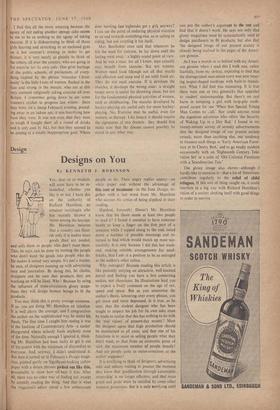Design
Designs on You
By KENNETH J. ROBINSON
You, dear sir or madam, will soon have to be re- modelled, whether you like it or not. I have this on the authority of Richard Hamilton, an amateur sociologist who • has recently thrown a A storm among the teacups. Mr. Hamilton believes that a country can flour- ish only if it makes more goods than are needed, and sells them to people who don't want them. This, he says, can be done by turning the people who don't want the goods into people who do. He makes it sound very simple. It's just a matter, he says, of designers teaming up with advertising men and journalists By doing this, he claims, designers can be sure that products they are working on will be liked. Why? Because by using the influence of mass-circulation glossy maga- zines they will design human beings to fit the Products.
You may think this is pretty average nonsense. [f so, you are doing Mr. Hamilton an injustice. ft is well above the average, and I congratulate he author on the sophisticated way he states his hesis. The first time I caught him stating it was it the Institute of Contemporary Arts—a zanies' 3layground where nobody fools anybody most )f the time. Naturally enough I ignored it, think- ng Mr. Hamilton had been lucky to get it out Pf his,system with the minimum of discomfort to weryone. And, anyway, I didn't understand it. But then it turned up in February's Design maga- fine, printed partly on Significant-looking yellow Paper with a dozen phrases picked out like this, presumably to show how off-beat it was After all, there was no other way of finding out, except by actually reading the thing. And that is' what he magazine's editor asked a few unfortunate people to do. Their angry replies appear—on white paper and without the advantage of this sort of treatment—in the June Design, to- gether with a last word from Mr. Hamilton who accuses his critics of being slipshod in their' reading.
Slipshod, forsooth! Doesn't Mr. Hamilton know that his thesis needs at least two people to read it? I found it essential to have someone handy to keep a finger on the first part of a sentence while I nipped along to the end, noted down a number of possible meanings and re- turned to find which would match up most suc- cessfully. It is only because I did this last week- end, making suitable arrangements for meal- breaks, that I am an a position to be as outraged as the author's other critics.
Why outraged? Because reading this article is like patiently untying an attractive, well-knotted parcel and finding you have a box containing snakes, not chocolates. Its illustrations lead you to expect a lively comment on the age of sex, speed and space. But as you anatomise the author's thesis, labouring over every phrase, you get more and more depressed. Is it true, as he says, that the student designer who has been taught to respect his job for its own sake must be made to realise that this has nothing to do with the 'real values' of present-day society? Must the designer agree that high production should be maintained at all costs, and that one of his functions is to assist in selling people what they don't want, so that from an economic point of view the maximum number of people benefit? And are people quite as status-conscious as the author supposes?
It is terrifying to think of designers, advertising men and editors waiting to pounce the moment they know that 'gratification through automobile ownership' is no longer effective, and that mass greed and pride must be satisfied by some other material possession. But it is only terrifying until you put the author's argument to the test and find that it doesn't work. He says not only that glossy magazines must be systematically used to design purchasers to fit products, but also that `the designed image of our present society is already being realised in the pages of the Ameri- can glossies.'
As I was a month or SO behind with my Ameri- can glossies when t read this I took one, rather fearfully, from my in-tray, expecting to find that the distinguished man-about-town was now wear- ing teapot-shaped eardrops with built-in transis- tors. What I did find was reassuring. It is true there were one or two gimmicks that appealed to readers' statusmanship. But there's no real harm in tempting a girl with loop-pile moth- proof carpet for use 'When that Special Young Man Comes to Nor could anyone mind the ingenious advertiser who offers 'the Security of Waking Up in a Dry Bed.' I found in my twenty-minute survey of seventy advertisements that the designed image of our present society reveals, more than anything else, our tendency to treasure such things as 'Early American Furni- ture at its Cheery Best,' and to go madly modern occasionally with an 'Eighteenth Century Tele- vision Set' or a suite of 'Old Colonial Furniture with a Scandinavian Tan.'
The glossy image also shows—although I hardly.like to mention it--that a lot of Americans contribute regularly to the relief of child refugees. If this sort of thing caught on, it could interfere in a big way with Richard Hamilton's vision of a society choking itself with good things in order to survive.










































 Previous page
Previous page